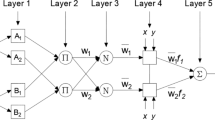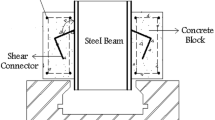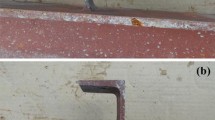Abstract
The V-shaped angle shear connector is recognized as to expand certain mechanical properties to the shear connectors, contains adequate ductility, elevate resistance, power degradation resistance under cyclic charging, and high shear transmission, more economical than other shear connectors, for instance, the L-shaped and C-shaped shear connectors. The performance of this shear connector had been investigated by previous researchers (Shariati et al. in Mater Struct 49(9):1–18, 2015), but the strength prediction was not clearly explained. In this investigation, the shear strength prediction of this connector was analyzed based on several factors. The ultimate purpose was to investigate the variations of different factors that were affecting the shear strength of this connector. To achieve this aim, the data (concrete compression strength, thickness, length, height, slope of inclination, and shear strength) were collected from the parametric studies using finite element analysis results for this purpose were input using the ANFIS method (neuro-fuzzy inference system). The finite element analysis results were verified by experimental test results. All variables from the predominant factors that were affected the shear strength of the shear connector (V-shaped angle) were also selected by using the ANFIS process. The results exhibited that the proposed shear connector (V-shaped angle) contained the potentiality to be used practically after several improvements. One option might be the improvement of the testing process for different predictive models with more input variables that will improve the predictive power of the created models.















Similar content being viewed by others
Change history
12 November 2019
The Editor-in-Chief has retracted this article [1] because validity of the content of this article cannot be verified.
12 November 2019
The Editor-in-Chief has retracted this article [1] because validity of the content of this article cannot be verified.
Abbreviations
- SS:
-
Silica sand
- WSS:
-
Silica sand weight
- WS:
-
Sieve weight
- Cum. Ret:
-
Cumulative retained
- \(\hbox {E}_{\mathrm{s}}\) :
-
The elasticity modulus
- \(\upgamma \) :
-
Density
- \(\upupsilon \) :
-
Poisson ratio
- \(f_{\mathrm{ck}}\) :
-
The concrete strength of cylinder specimen
- \(f_{\mathrm{cu}}\) :
-
The concrete strength of cubic specimen
- \(\upvarepsilon _{\mathrm{c1}}\) :
-
Strain
- r:
-
The reduction factor
- \(\upvarepsilon _{\mathrm{cu}}\) :
-
The ultimate strain at failure
- \(\hbox {E}_{\mathrm{cm}}\) :
-
The elasticity module
- \({\varvec{\upvarepsilon }}\) :
-
The eccentricity
- \(\Psi \) :
-
The material dilation angle
- \(\hbox {f}_{\mathrm{b}0}\) :
-
The biaxial compressive strength
- \(\hbox {f}_{\mathrm{c}0}\) :
-
The uniaxial compressive strength
- d:
-
Penetration measure in the contact region
- r:
-
Fraction of the minimum element length
- \(\hbox {L}_{\mathrm{elem}}\).:
-
Element length
- \(K\hbox {i}\) :
-
Initial stiffness
- i:
-
The segment member
- S:
-
Geometric scale factor
- \(\hbox {k}_{\mathrm{dflt}}\) :
-
Default stiffness
- r:
-
Overclosure factor
- d:
-
Overclosure measure
- \(\hbox {S}_{0}\) :
-
The initial scale factor;
- \(\mu _{AB} \left( x \right) , \mu _{CD} \left( x \right) \) :
-
The membership function
- \(\left\{ {a_i, b_i, c_i, d_i } \right\} \) :
-
The set of parameters
- “x” and “y”:
-
The values of inputs from the nodes
- \(\left\{ {p_i, q_i, r} \right\} \) :
-
The v 10.1007/s10845-017-1306-6 ariable set designated as consequent parameters
- \(P_{i }\) :
-
The experimental value
- \(O_{i}\) :
-
Signifies the forecast value
- n :
-
The total number of test data
References
Al-Ghandoor, A., & Samhouri, M. (2009). Electricity consumption in the industrial sector of Jordan: application of multivariate linear regression and adaptive neuro-fuzzy techniques. JJMIE, 3(1), 69–76.
Azimi, M., et al. (2015). Seismic performance of ductility classes medium RC beam-column connections with continuous rectangular spiral transverse reinforcements. Latin American Journal of Solids and Structures, 12(4), 787–807.
BSI, B. (1992). Concrete performance, production, placing and compliance criteria. In DD ENV 206:1992., London.
Cement, A. P. (1993). ASTM C 150, Type I or II, except Type III may be used for cold-weather construction. In Provide natural color or white cement as required to produce mortar color indicated 1.
Clouston, P., Bathon, L. A., & Schreyer, A. (2005). Shear and bending performance of a novel wood-concrete composite system. Journal of Structural Engineering, 131(9), 1404–1412.
Cornelissen, H., Hordijk, D., & Reinhardt, H. (1986). Experimental determination of crack softening characteristics of normalweight and lightweight concrete. HERON, 31(2), 1986.
EN, C. (2004). 1-1, Eurocode 4: Design of composite steel and concrete structures–Part 1.1: General rules and rules for buildings. Brussels: European Committee for Standardization.
Ekici, B. B., & Aksoy, U. T. (2011). Prediction of building energy needs in early stage of design by using ANFIS. Expert Systems with Applications, 38(5), 5352–5358.
Ellobody, E. (2002). Finite element modeling of shear connection for steel concrete composite girders. Ph.D. thesis, School of Civil Engineering, The University of Leeds, Leeds.
Ernst, S., Patrick, M., Wheeler, A. (2004). Novel shear stud component for secondary composite beams. In Proceedings of the 18th Australian conference on the mechanics of structures and materials, Balkema, The Netherlands.
Focacci, F., Foraboschi, P., & Stefano, M. D. (2015). Composite beam generally connected: Analytical model. Composite Structures,. doi:10.1016/j.compstruct.2015.07.044.
Galjaard, H., Walraven, J., Eligehausen, R. (2001). Static tests on various types of shear connectors for composite structures. In International Symposium on Connections between Steel and Concrete (pp. 1313–1322). RILEM Publications SARL.
Hasselhoff, J., et al. (2015). Design, manufacturing and testing of shear-cone connectors between CFRP stay-in-place formwork and concrete.Composite Structures, 129, 47–54.
Hauke, B., (2005). Shear connectors for composite members of high strength materials. In textit4th European conference on steel and composite (pp. 4.2.57–64).
Hegger, J., et al. (2001). Studies on the ductility of shear connectors when using high-strength concrete. In International Symposium on Connections between Steel and Concrete, University of Stuttgart (pp. 1025–1045).
Hibbitt, K., Karlsson, B., & Sorensen, P. (1988). ABAQUS: User’s Manual. Hibbitt, Karlsson & Sorensen.
Jang, J.-S. (1993). ANFIS: Adaptive-network-based fuzzy inference system. Systems, Man and Cybernetics, IEEE Transactions on, 23(3), 665–685.
Karimi, K., Tait, M. J., & El-Dakhakhni, W. W. (2011). Testing and modeling of a novel FRP-encased steel-concrete composite column. Composite Structures, 93(5), 1463–1473.
Khajeh, A., Modarress, H., & Rezaee, B. (2009). Application of adaptive neuro-fuzzy inference system for solubility prediction of carbon dioxide in polymers. Expert Systems with Applications, 36(3), 5728–5732.
Kurnaz, S., Cetin, O., & Kaynak, O. (2010). Adaptive neuro-fuzzy inference system based autonomous flight control of unmanned air vehicles. Expert Systems with Applications,37(2), 1229–1234.
Lameiras, R., et al. (2013). Development of sandwich panels combining fibre reinforced concrete layers and fibre reinforced polymer connectors. Part II: Evaluation of mechanical behaviour. Composite Structures, 105, 460–470.
Lawan, M. M., Tahir, M. M., & Mirza, J. (2016). Bolted Shear connectors performance in self-compacting concrete integrated with cold-formed steel section. Latin American Journal of Solids and Structures, 13(4), 731–749.
Leonhardt, F., et al. (1987). New improved shear connector with high fatigue strength for composite structures. Beron-und Stahlbetonbau Heft, 12(12), 325–331.
Liew, J., & Wang, T. (2011). Novel steel-concrete-steel sandwich composite plates subject to impact and blast load. Advances in Structural Engineering, 14(4), 673–688.
Maleki, S., & Bagheri, S. (2008a). Behavior of channel shear connectors, Part I: Experimental study. Journal of Constructional Steel Research, 64, 1333–1340.
Maleki, S., & Bagheri, S. (2008b). Behavior of channel shear connectors, Part II: Analytical study. Journal of Constructional Steel Research, 64, 1341–1348.
Maleki, S., & Mahoutian, M. (2009). Experimental and analytical study on channel shear connectors in fiber-reinforced concrete. Journal of Constructional Steel Research, 65(8–9), 1787–1793.
Manual A. S. U. (2010). Version 6.10. : ABAQUS Inc.
Mastali, M., et al. (2015). Development of innovative hybrid sandwich panel slabs Part I: Experimental results. Composite Structures,. doi:10.1016/j.compstruct.2015.07.114.
Nguyen, H., & Kim, S. (2009). Finite element modeling of push-out tests for large stud shear connectors. Journal of Constructional Steel Research, 65(10–11), 1909–1920.
Pawar, E. G., Banerjee, S., & Desai, Y. M. (2015). Stress Analysis of Laminated Composite and Sandwich Beams using a Novel Shear and Normal Deformation Theory. Latin American Journal of Solids and Structures, 12(7), 1340–1361.
Petković, D., et al. (2012). Adaptive neuro-fuzzy estimation of conductive silicone rubber mechanical properties. Expert Systems with Applications, 39(10), 9477–9482.
Petković, D., et al. (2012). Adaptive neuro fuzzy controller for adaptive compliant robotic gripper. Expert Systems with Applications, 39(18), 13295–13304.
Rowe, R., et al. (1987). Handbook to British standard BS 8110: 1985: structural use of concrete (Vol. 1). Farnham: Palladian Publications.
Safa, M., et al. (2016). Potential of adaptive neuro fuzzy inference system for evaluating the factors affecting steel-concrete composite beam’s shear strength. Steel and Composite Structures, An International Journal, 21(3), 679–688.
Sajedi, F., & Abdul Razak, H. (2010). Thermal activation of ordinary Portland cement-slag mortars. Materials and Design, 31(9), 4522–4527.
Sajedi, F., & Razak, H. A. (2010). The effect of chemical activators on early strength of ordinary Portland cement-slag mortars. Construction and Building Materials, 24(10), 1944–1951.
Sajedi, F., & Razak, H. A. (2011). Effects of thermal and mechanical activation methods on compressive strength of ordinary Portland cement-slag mortar. Materials and Design,32(2), 984–995.
Shariati, M. (2013). Behaviour of C-shaped shear connectors in steel concrete composite beams. PhD Thesis, Faculty of engineering University of Malaya, Kuala Lumpur, Malaysia.
Shariati, M., et al.(2012a). Fatigue energy dissipation and failure analysis of channel shear connector embedded in the lightweight aggregate concrete in composite bridge girders. In Fifth 25 international conference on engineering failure analysis 1–4 July 2012, Hilton Hotel, The Hague, The Netherlands.
Shariati, A., et al. (2012b). Various types of shear connectors in composite structures: A review. International Journal of Physical Sciences, 7(22), 2876–2890.
Shariati, A., et al. (2014). Experimental assessment of angle shear connectors under monotonic and fully reversed cyclic loading in high strength concrete. Construction and Building Materials, 52, 276–283.
Shariati, M., et al. (2015). Behavior of V-shaped angle shear connectors: experimental and parametric study. Materials and Structures, 49(9), 1–18.
Singh, R., Kainthola, A., & Singh, T. (2012). Estimation of elastic constant of rocks using an ANFIS approach. Applied Soft Computing, 12(1), 40–45.
Sohel, K. M. A., et al. (2012). Behavior of Steel-Concrete-Steel sandwich structures with lightweight cement composite and novel shear connectors. Composite Structures, 94(12), 3500–3509.
Tian, L., & Collins, C. (2005). Adaptive neuro-fuzzy control of a flexible manipulator. Mechatronics,15(10), 1305–1320.
Toghroli, A., et al. (2014). Prediction of shear capacity of channel shear connectors using the ANFIS model. Steel and Composite Structures, 17(5), 623–639.
Toghroli, A., et al. (2016). Potential of soft computing approach for evaluating the factors affecting the capacity of steel–concrete composite beam. Journal of Intelligent Manufacturing. doi:10.1007/s10845-016-1217-y.
Yang, K.-H., Byun, H.-Y., & Ashour, A. F. (2009). Shear strengthening of continuous reinforced concrete T-beams using wire rope units.Engineering Structures, 31(5), 1154–1165.
Yan, J.-B., & Richard Liew, J. Y. (2016). Design and behaviour of steel-concrete-steel sandwich plates subject to concentrated loads. Composite Structures, 150, 139–152.
Zellner, W. (1987). Recent designs of composite bridges and a new type of shear connectors. Composite Construction in Steel and Concrete, II, 240–252.
Acknowledgements
This research was supported by Birjand University of Technology grant (Project No. RP/95/1003). The authors would like to acknowledge this support.
Author information
Authors and Affiliations
Corresponding author
Additional information
The Editor-in-Chief has retracted this article because validity of the content of this article cannot be verified. This article showed evidence of authorship manipulation. None of the authors agree to this retraction.
About this article
Cite this article
Mansouri, I., Shariati, M., Safa, M. et al. RETRACTED ARTICLE: Analysis of influential factors for predicting the shear strength of a V-shaped angle shear connector in composite beams using an adaptive neuro-fuzzy technique. J Intell Manuf 30, 1247–1257 (2019). https://doi.org/10.1007/s10845-017-1306-6
Received:
Accepted:
Published:
Issue Date:
DOI: https://doi.org/10.1007/s10845-017-1306-6




